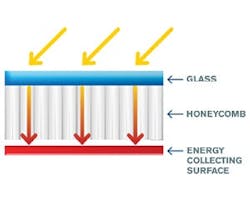Are Honeycomb Solar Thermal Collectors More Efficient?
A new solar thermal hot water technology delivers more efficient heating than comparable technologies, but field testing by the GSA found that the systems are likely only cost-effective in certain applications.
As part of its Green Proving Ground initiative, GSA installed honeycomb solar thermal collectors on two buildings (the Major General Emmett J. Bean Center in Indianapolis and the GSA Regional Headquarters Building in Auburn, WA) to determine whether the system delivers on its claims of high efficiency and minimal system heat loss compared to conventional solar thermal collectors.
Flat-plate solar thermal systems use a flat solar collection surface to capture sunlight, which is used to heat fluid that is then directed into a storage tank. Honeycomb models place transparent insulation in the shape of a honeycomb above the energy-collecting surface, which allows solar radiation to pass through to the collection surface while suppressing convection to minimize heat loss.
Compared to conventional flat-plate collectors, GSA’s field tests found that the honeycomb technology delivered higher instant efficiency than all of the other systems in configurations where higher fluid temperatures are needed but tended to underperform when the needed fluid temperature is lower (i.e. in the range of 140 degrees F., the most common application).
The honeycomb technology would likely be much more efficient in applications where the fluid entering the collector is always close to the 140-degree hot water setpoint, such as hot water hydronic loop reheating and space heating. The application simulated for this study required a much lower average inlet fluid temperature.
The systems were not cost-effective for either of the buildings in the study, in part due to the high upfront cost. However, the systems could deliver cost-savings in some applications. Consider solar thermal hot water if your building has:
1) Central domestic hot water. Facilities with small, decentralized point-of-use systems are not applicable for solar thermal installations. Large central systems offer an economy of scale, according to the report.
2) Large hot water loads. Does your facility have kitchens, heated pools, and showers? Solar thermal systems may be a good match, assuming your water loads are consistent throughout the week and year. “The larger the load being offset, the more cost-effective the systems,” GSA notes.
3) High energy costs. “The natural gas industry has experienced significant cost reductions over the last few years,” GSA says. “The economics of the solar thermal system is sensitive to fuel source costs. The unit cost of energy from electricity is many times higher than natural gas in certain locations. Solar water heating also competes with the high costs of propane and fuel oil.”
GSA recommends using a detailed sub-hourly simulation program to calculate lifecycle costs and optimize cost-effectiveness when exploring whether to install solar hot water at a facility. The system should be modeled with SRCC-rated solar thermal panel performance data, which will ensure that you end up with the right size of system and provide you with accurate analysis.
